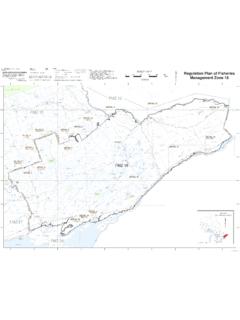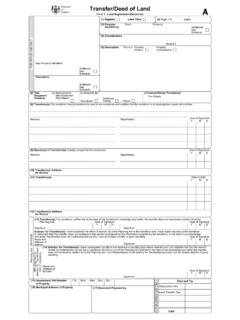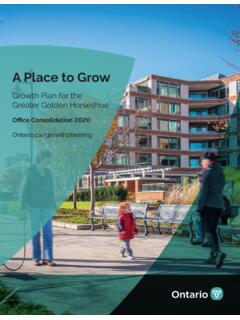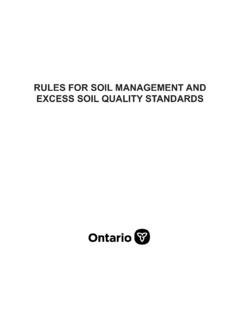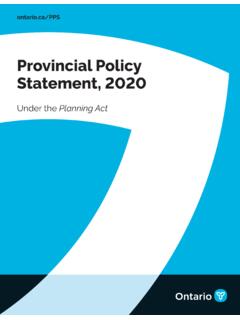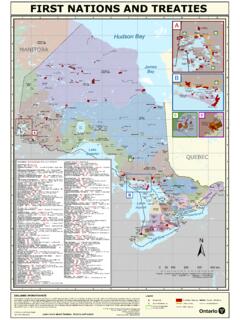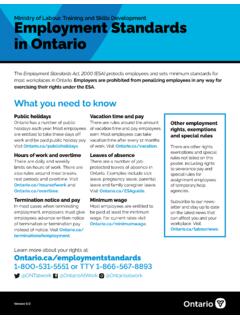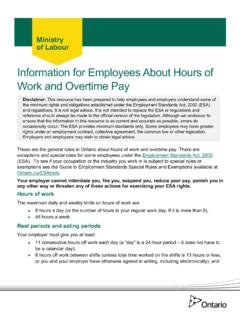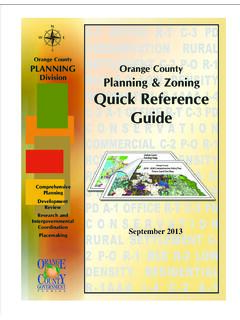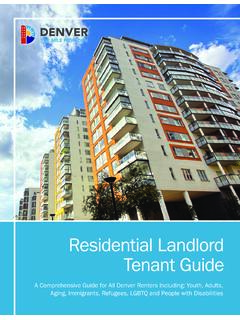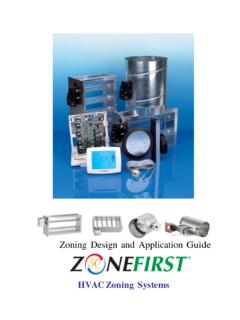Transcription of Build or buy a tiny home - Premier of Ontario
1 An innovation guide under More Homes, More Choice: Ontario 's Housing Supply Action Plan Build or buy a tiny home Ontario Building Code Information Introduction Are you thinking about having a tiny home on your property? Not only are they a great way to save on housing costs, they are also cheaper to Build and maintain than a regular house. If you are interested in building or buying a tiny home, this guide will provide you with useful information as you move ahead with your project. This guide applies only to newly built stand-alone tiny homes that are separate buildings from existing structures on a property. For the purposes of this guide, the types of tiny homes discussed are new small houses that are either: built on site built in a factory and then brought to a property Renovating an existing building on a property to add a dwelling unit is not discussed in this guide.
2 If you are planning to renovate an existing, separate structure on your property such as a garage, coach house or laneway house, you should contact your local planning and building departments for more information about how to proceed. You can also read the guide Add a second unit in your house, with information on what you need to know about adding a second unit inside your house. Disclaimer: This document is provided for convenience only and should not be relied upon as a substitute for construction, engineering, architectural or legal advice. The Ministry of Municipal Affairs and Housing does not assume responsibility for errors or oversights resulting from use of this document. tiny home For the purposes of this guide, a tiny home is a small, private and self-contained dwelling unit: with living and dining areas with kitchen and bathroom facilities Figure 1: A tiny home with a sleeping area on wheels intended for year-round use A tiny home can be a primary home or a separate structure on a property that already has an existing house.
3 Campers, recreational vehicles, cottages and other structures used on a seasonal basis are not considered tiny homes. On the right are three common examples of a tiny home. Despite their size, tiny homes must comply with the health and safety requirements of Ontario 's Building Code, municipal zoning and other local by-laws. tiny homes must also have necessary servicing such as water and sewage. tiny home sizes Figure 2: A site-built tiny home The size of a tiny home varies from municipality to municipality, depending on standards set out in zoning by-laws. Some municipalities have minimum size requirements, while others have maximum size requirements. For example, some municipal by-laws require a tiny home to be 37 m2 (400 ft2) or less. In all cases, a tiny home cannot be smaller than the minimum required size set out in Ontario 's Building Code, which is m2. (188 ft2). Add a tiny home to your property Before you decide to add a tiny home to your property, it is important that you first speak with your local municipal planning and building departments.
4 They can tell you whether you can add or Figure 3: A shipping container Build a tiny home to your property and answer questions related to tiny home (not yet located on the Building Code, zoning and other by-laws. a site). Build or buy a tiny home | 3. Some of the important things you should talk recommend you hire at least one of to your municipality about as you consider the following: building a tiny home include: Building Code designer registered with municipal zoning requirements that the Ontario government apply to your property professional planner designing your tiny home to comply architect with the Building Code engineer getting necessary building permits These professionals and your builder can required building inspections during help you get all the necessary approvals, construction building permits and arrange for parking requirements construction inspections.
5 Size requirements for tiny homes, if any rules about connecting to municipal You can check the qualifications of a services, if available provincially registered Building Code designer at To help you through the sometimes- complex approval and building process, we Before you start The idea of tiny home living is not new. Over the 1. Is your property suitable? last few years, tiny homes have been getting a Some lots will not work for a tiny home. There lot of attention as a housing choice for people are several reasons why this may be the case: to live in or rent out. a. Local zoning by-laws may not permit Adding or building a tiny home to your property adding a tiny home without further can sometimes be a challenge. Unlike the municipal approval (see section on regular-sized houses we have been building for Municipal zoning and other by-laws). decades, tiny homes are an emerging trend.
6 As such, getting successfully through approvals b. The lot may be too small to meet and meeting requirements to Build a tiny home setbacks or other local requirements can be difficult. without further municipal approval (see section on Municipal zoning and other Below are three things you should check by-laws). before you go any further with your project: c. The lot may not have adequate access for emergency services such as firefighting and Emergency Medical Services (see section on Emergency access). Build or buy a tiny home | 4. 2. If you're buying a factory-built tiny home, Municipal zoning and does it meet the necessary Canadian other by-laws Standards Association (CSA) standards? Before building your tiny home, it is important The Building Code requires all buildings to to get information about your municipality's be inspected during construction. In the case zoning by-laws.
7 zoning by-laws set out the of factory-built buildings, quality control kind of buildings that can be built, the sizes inspections and monitoring occur during they can be and where they can be located the assembly of buildings and building on your property. As a result, they may components. A tiny home built off-site control whether a tiny home is permitted without CSA certification will likely not have in your case. Ask your local planning had the appropriate inspections. This may department about: become an issue as you apply for a building permit to locate your tiny home on your zoning rules that apply to your property. (See section on Factory-built property tiny homes) whether these rules let you Build a tiny home without further municipal 3. Will your tiny home have warranty permissions protection under the Ontario New Home services to your property such as Warranties Plan administered by Tarion?
8 Water, sewage and electricity In Ontario , all new home builders must be any other useful information you need registered with Tarion. Tarion maintains an to know to Build your tiny home Ontario Builder Directory of all new home Even though tiny homes are small, they must builders. New home buyers are encouraged still meet the local rules for building in your to check the Ontario Builder Directory to area, including zoning by-laws. Complying ensure their builder is registered with Tarion. with your municipality's by-laws is important Tarion's website outlines the types of homes so that you can Build a tiny home if you covered and not covered by their warranties choose to proceed. and protections. Depending on where your tiny home is To check these three things, you are strongly located (rural, suburban or urban areas), advised to talk with officials at your local municipal zoning by-laws and standards municipality and seek assistance from will vary.
9 Experts in this area before you go further with your project. zoning requirements that could impact building your tiny home without further municipal permissions may include: permitted land uses minimum lot sizes Build or buy a tiny home | 5. minimum size for residential buildings You will generally need to apply to your minimum or maximum lot coverage by municipality to change the specific rules that built structures apply to your property. lot frontage and setback requirements Below are typical examples of circumstances from lot lines and the public street where a rezoning or a minor variance may massing and height requirements be needed so that you can proceed with parking requirements (including your tiny home project. In cases like these, tandem parking). you should speak to planning staff in your Other requirements that could impact municipality. You may also wish to seek the building your tiny home may include: help of a professional planner.
10 Streetscape and architectural design 1. zoning by-law amendment/rezoning location of exits and entrances A rezoning is needed when you want to use appropriate municipal or private or develop your property in a way that is servicing (water, sewage, not allowed by the existing zoning by-law. It electricity etc.). will be needed when you are proposing to whether new residential development change some of the basic rules about how a can occur in existing settlement areas property is used, such as changing restrictions on lot severance from a single dwelling unit to multiple access for emergency services dwelling units. You need to learn about how these things A rezoning is also often needed when the apply specifically to your property. Knowing change you want is a fairly major change to these rules can make building or buying a the zoning by-law, such as adding another tiny home go quicker and smoother.

